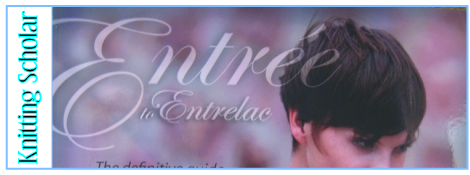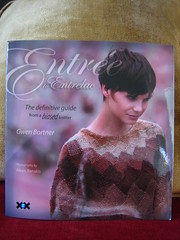First, the facts:
Title:
Author: Gwen Bortner
Published by: XRX Publications, 2010
Pages: 159
Type: Patterns, How-to.
Chapters:
1. Entrelac Basics
2. Simple Shapes and Seams
3. Intriguing Construction
4. Color, Texture and Other Creative Units
5. Designing with Entrelac
Pattern Size Range: Varies
The In-Depth Look:
I’ve always thought of entrelac as one of those knitting techniques that people either love or they hate. It’s not one of the favored children like cables or color work that everybody at least claims to admire, even if they don’t enjoy the actual process. No, entrelac has always been like the ugly duckling of knitting, the technique that is misunderstood or disliked on principle, because nobody’s really gotten to know it.
Well, here’s the introduction you’ve been waiting for. Entree to Entrelac is a thorough
examination of entrelac techniques.
What? You thought there was only one, basic method of doing entrelac? It’s just a matter of picking up and knitting interlocking squares that look like basket-weave, isn’t it? With maybe the occasional triangle? No, it turns out it’s a lot more than that, and the author explores it all, with good diagrams to help along the way.
There are a lot of patterns here, too, to give you some inspiration in the use of entrelac. One color, two-color, multi-color. Faux-argyle. Plain stockinette, or designs with lace or cables. Full-piece entrelac designs, as well as pieces that only use it for interesting details.
My only real problem with entrelac … other than the endless ends to weave in, which the book gives tips for … is that after a while, so many of the designs look the same. It all comes down to little squares piecing together a pattern, like a knitted quilt that always looks like a checkerboard. That doesn’t mean I don’t like it, just that, collections of entrelac often bore me because everything looks so much alike except for the basic color scheme.
In that regard, there is a lot of similarity in designs here, but the consistency of its structure is one of entrelac’s advantages. When employed properly, it lends itself to diagonal lines, zig-zags, and yes, checkerboard patterns beautifully–and with a lot more ease than trying to do similar color changes with intarsia. The point is to take the basic idea of the technique–its basketweave pattern that is built right in to the structure–and explore its possibilities, which this book does very well. Some of the designs come out looking too busy to my eye (and there was one sweater which I won’t name that I thought was pretty atrocious), but there are more of them that look wonderful. And the pullover in “Touch Me” yarn? It looks like woven velvet.
All in all? A revelation, even if the author does admit to being “biased.” You can get your copy at Amazon.com.
Want to see bigger pictures? Click here.

This review copy was kindly donated by XRX. Thank you!



Comments on this entry are closed.